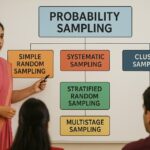In any research that involves data collection from a population, one of the most crucial steps is defining whom to collect the data from. This is where the concept of a sampling frame comes into play. A sampling frame is not the sample itself, but the source from which the sample is drawn. It is the list or database of elements (individuals, households, institutions, etc.) that defines the population for a study.
What is a Sampling Frame?
A sampling frame is a list of all the units in the population from which a sample can be drawn. It acts as a boundary between the actual population and the selected sample. It could be a database, a list, a directory, or any well-defined source that includes the target respondents for your study. It acts as a bridge between the target population and the actual sample selected for study.
To put it simply:
- Population: The entire group you’re interested in
- Sampling Frame: A complete list or database of that group
- Sample: The portion you actually select from the frame for data collection
A sampling frame is to a sample what a map is to a traveller.
Examples of Sampling Frames:
- Electoral rolls for political surveys.
- School enrolment registers for education research.
- Customer databases for marketing studies.
- Hospital patient records for medical research.
Why is Sampling Frame Important?
A well-defined sampling frame:
- Ensures that every element has a known and non-zero chance of being selected
- Minimizes sampling bias
- Improves the representativeness of the sample
- Helps in estimating population parameters accurately
Importance of a Sampling Frame
A sampling frame is important because:
- It defines the accessible population.
- It ensures coverage—the sample should adequately represent the population.
- It helps in choosing appropriate sampling techniques (Probability or Non- Probability).
- It prevents sampling errors by allowing control over who is included/excluded.
A Poor Sampling Frame can lead to:
- Under-coverage (e.g., missing rural respondents in an urban-dominated list)
- Over-coverage (e.g., including outdated or irrelevant entries)
- Bias that distorts the study outcomes.
Practical Examples Across Domains
Let’s explore how sampling frames are applied in different sectors:
1. Education Domain
Example: A study is conducted to evaluate the effectiveness of online learning among high school students in Tamil Nadu.
- Population: All high school students in Tamil Nadu
- Sampling Frame: The official enrollment database of students provided by the Tamil Nadu State Education Department
- Sample: 500 students randomly selected from that database
Challenges:
- If the database is outdated or incomplete, some students might be excluded, leading to under-coverage
- If the frame includes students who dropped out, it could affect the relevance of the results
Best Practice: Regularly update the student database and cross-check with school records to build an accurate frame.
2. Healthcare Domain
Example: A study is conducted to assess the awareness of diabetic complications among patients aged 50 and above in Kolkata.
- Population: All diabetic patients aged 50+ in Kolkata
- Sampling Frame: Patient records maintained by major government and private hospitals in the city
- Sample: 300 patients selected using stratified sampling from hospital records
Challenges:
- Patients visiting local clinics or traditional healers may not be included in hospital records
- Inaccurate or duplicate entries in medical records can lead to errors
Best Practice: Use a combination of government and private hospital databases and clean the data for duplicates and missing values.
3. Marketing and Business Research
Example: A company wants to study the brand loyalty of its smartwatch users across India.
- Population: All users who have purchased the smartwatch brand in India
- Sampling Frame: The customer registration database maintained by the company (from warranty cards and app registrations)
- Sample: 1,000 customers selected using systematic sampling
Challenges:
- Only registered users are included, so customers who didn’t register are left out
- Contact details might be missing or outdated
Best Practice: Encourage customers to register via incentives and keep the CRM (Customer Relationship Management) system updated.
4. Social Research / Policy Studies
Example: A non-profit organization wants to study the employment status of rural women in Maharashtra.
- Population: All working-age women living in rural parts of Maharashtra
- Sampling Frame: The electoral rolls or data from the Panchayat Raj system
- Sample: 600 women chosen from 10 randomly selected villages
Challenges:
- Women without official IDs may not appear in electoral rolls
- Migration and seasonal employment may cause data gaps
Best Practice: Use multiple sources like local NGO records, employment schemes, and Gram Sabha data for cross-verification.
Common Problems with Sampling Frames
Despite its importance, constructing an accurate sampling frame can be challenging:
- Under-coverage: Some population members are not listed (e.g., unregistered voters)
- Over-coverage: Including irrelevant units (e.g., deceased people in electoral rolls)
- Duplication: Same unit appearing more than once (e.g., repeat customers listed twice)
- Outdated Information: Addresses or contact details may be incorrect
- Lack of Access: Many informal sector workers or self-help group members are not officially registered.
- Dynamic Populations: Migrant laborers or gig workers may frequently change locations.
In such cases, researchers must adopt innovative or adaptive sampling techniques, often combining multiple sources or using purposive strategies.
Role of Sampling Frame in Selecting the Sampling Technique
The nature and quality of the sampling frame often dictate which sampling method can be used. For example:
- If you have a complete and updated list, you can perform Simple random sampling.
- If your frame includes demographic details, you can do Stratified sampling.
- If a formal list isn’t available, researchers may resort to Non-probability methods.
Examples:
A telecom company with a detailed customer database including age, location, and purchase history can use stratified random sampling to study satisfaction across age groups.
Conducting research on consumers of green electronic products in Mumbai.
Since there is no concrete sampling frame (list of consumers using green electronic products in Mumbai) available, the researcher can use any non-probability sampling method.
Sample Wording for Your Methodology:
“Given the absence of a formal sampling frame of green electronic product consumers in Mumbai and the targeted nature of the study, purposive sampling was adopted. Respondents were selected based on their prior purchase or usage of eco-friendly electronic products, etc. To further expand the sample, a snowball sampling technique was employed, where existing participants referred others with similar product usage behaviour.”
Tips to Improve the Quality of a Sampling Frame
- Use official and updated sources whenever possible
- Verify the completeness and accuracy of the list
- Cross-check the frame with field-level information
- For online surveys, screen respondents carefully to ensure relevance
- Combine multiple sources for broader coverage if one source is insufficient
Final Thoughts
A sampling frame is more than just a list—it is a strategic tool that ensures the credibility of your research. Whether you’re working in education, healthcare, marketing, or social development, choosing the right sampling frame can make the difference between a reliable study and a misleading one.
By understanding its purpose, evaluating its quality, and applying it carefully, researchers and analysts can significantly reduce bias and improve the validity of their findings. Always remember: your research can only be as good as your sampling frame.
In research, it’s not just what you study, but how you select who or what you study that determines the strength of your conclusions.
Need assistance in selecting the samples of your research, contact us!









Leave a Reply